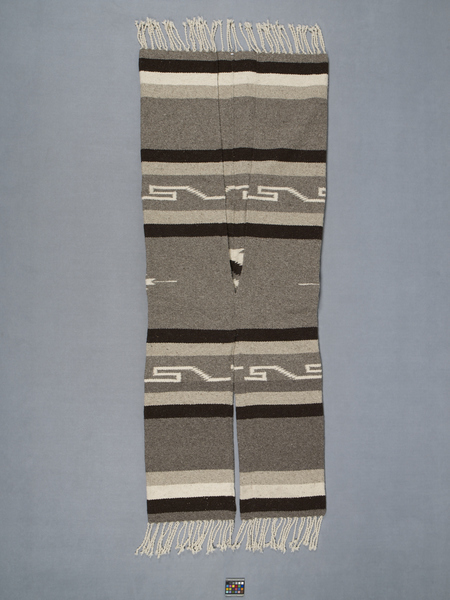Devil Costume Item Number: 3244/1 from the MOA: University of British Columbia

Description
Woolen costume. One-piece suit is woven of thick wool, dyed in horizontal stripes of varying width in shades of grey, tan, and dark brown. Stepped line patterns are incorporated into the weave in some areas, and a large concentric diamond pattern sits at hips on back. Short twisted tassels in light tan are attached at both the ankles and top edge of the garment. From two wide legs, the piece extends up over the hips, with a split up the centre to the top edge.
History Of Use
Costumes such as these, along with masks, are worn during “Easter Battles” that take place in front of the main church in San Bartolomé Aguas Caliente, in the Apaseo el Alto Municipality. Because the Spanish missionaries forced the association of pre-Columbian deities with the the Devil, it is possible that the native peoples of Mesoamerica sympathised with the Devil. Lucifer’s rebellion and ejection from hell may have struck a chord with the people’s own vilification and re-sultant uprisings. At Easter in San Bartolomé the central plaza becomes a battlefield between hundreds of masked, costumed devils and the un-masked, purple t-shirted followers of Christ. The Devils are called 'cornudos' (horned ones). Filling the battlefield, both factions move back and forward, fighting in pairs and using steel-bladed machetes. No side seems to win. The masked cornudos stay for a few days until Christ is resurrected; then they disappear for another year. The costume would be worn with the upper edge caught in the band of the mask at the back of the neck, with the sides hanging down over the shoulders.
Cultural Context
festivals; carnival
Narrative
In 2017 Guanajuato was one of the Mexican states most affected by drug-related crime. Authorities from the Apaseo municipality were made uncomfortable by inquiries concerning this context. Shortly before this mask was collected, there was a large unexplained explosion in Apaseo, which locals attributed to organised crime units.
Item History
- Made in San Bartolo, Guanajuato, Mexico during 2015
- Collected during 2017
- Owned by Anthony A. Shelton before May 24, 2017
- Received from Anthony A. Shelton (Donor) on May 24, 2017
What
- Name
- Devil Costume
- Identification Number
- 3244/1
- Type of Item
- costume
- Material
- wool fibre
- Overall
- height 232.0 cm, width 75.0 cm
Who
- Culture
- Mexican
- Previous Owner
- Anthony A. Shelton
- Received from
- Anthony A. Shelton (Donor)
Where
- Holding Institution
- MOA: University of British Columbia
- Made in
- San Bartolo, Guanajuato, Mexico
When
- Creation Date
- during 2015
- Collection Date
- during 2017
- Ownership Date
- before May 24, 2017
- Acquisition Date
- on May 24, 2017
Other
- Item Classes
- textiles
- Condition
- excellent
- Accession Number
- 3244/0001